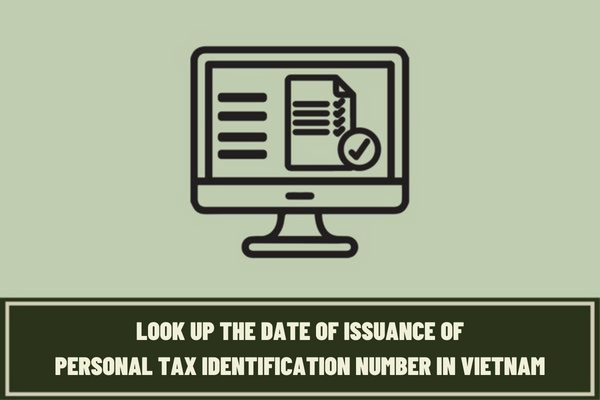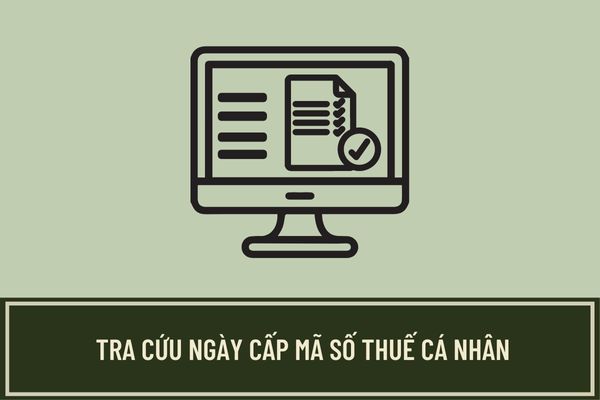Instructions on how to look up the date of issuance of the personal tax identification number in the simplest way? How are tax identification numbers used?
Instructions on how to look up the date of issuance of the personal tax identification number in the simplest way?
Currently, when an individual wishes to know what date his/her personal tax identification number was issued, he/she can check the date of issuance of his/her personal tax identification number in the following ways:
- Step 1: Access the Website http://tracuunnt.gdt.gov.vn/tcnnt/mstcn.jsp
- Step 2: Select the section Information about PIT payers
- Step 3: Taxpayers proceed to enter personal tax identification number or identity card number/citizen identity number and confirmation code as required by the system.
- Step 4: Taxpayers choose Lookup and see the displayed tax identification number date information.

Instructions on how to look up the date of issuance of the personal tax identification number in the simplest way? How are tax identification numbers used?
Is the tax identification number the enterprise identification number?
Pursuant to Clause 1, Article 29 of the 2020 Law on Enterprises in Vietnam, enterprise identification number is a serial number generated by the National Enterprise Registration Information System, issued to the enterprise when it is created and written on the Certificate of Enterprise Registration.
Each enterprise shall have a sole EID number, which must not be issued to any other enterprise.
At the same time, according to Clause 1, Article 8 of Decree No. 01/2021/ND-CP, each enterprise is issued with a single enterprise ID number. This number is also the enterprise’s taxpayer identification number and social insurance participant’s code.
How are tax identification numbers used?
According to the provisions of Article 35 of the 2019 Law on Tax Administration in Vietnam, the use of tax identification numbers is as follows:
- Taxpayers must include their TINs in invoices, records and/or materials when making business transactions; opening deposit accounts at commercial banks and/or other credit institutions; declaring tax, pay tax, applying for tax exemption, tax reduction, tax refund and/or tax cancellation; filing customs declarations and making other tax-related transactions for all amounts payable to the state budget, including the case where taxpayers’ businesses operate across different locations.
- Taxpayers must provide their TINs to relevant agencies and/or organizations or include their TINs in their applications when following administrative procedures of tax authorities via the interlinked single-window system.
- Tax authorities, the State Treasury and commercial banks and other organizations authorized by tax authorities to collect tax shall use TINs of taxpayers for the purpose of tax administration and tax collection.
- Commercial banks and other credit institutions must include TINs in the taxpayers’ applications for opening accounts and in records of transactions via accounts.
- Other organizations and individuals participating in tax administration shall use TINs of taxpayers when providing information related to the determination of tax liabilities.
- When a Vietnamese party makes a payment to an organization/individual whose cross-border business is based on a digital intermediary platform outside of Vietnamese territories, it must use the TIN assigned to this organization/individual to deduct and pay tax on behalf of such organization/individual.
- Personal identification numbers shall replace TINs when they are issued to the whole population.
What is the time limit for first-time taxpayer registration in Vietnam?
Pursuant to Clause 1, Article 33 of the 2019 Law on Tax Administration in Vietnam stipulating as follows:
Time limit for first-time taxpayer registration in Vietnam
1. For taxpayers who combine taxpayer registration with business registration, the time limit for taxpayer registration is the time limit for business registration as prescribed by law.
2. For taxpayers directly registered with tax authorities, the time limit for taxpayer registration is 10 working days starting from the day on which:
a) the certificate of household business registration, establishment and operation license, investment registration certificate or establishment decision is granted;
b) the taxpayer inaugurates business operation for organizations that are not required to apply for business registration and household businesses and individual businesses that are required to apply for business registration but yet to be granted the business registration certificate;
c) the responsibility to deduct and pay tax on behalf of individuals arises; organizations paying tax on behalf of individuals according to business cooperation contracts and/or agreements;
d) the contract with the foreign contractor and/or subcontractors who directly declare and pay tax to tax authorities; the petroleum contract or agreement is concluded;
dd) personal income tax is incurred;
e) tax refund in claimed;
g) other amounts payable to the state budget are incurred.
3. In case an individual does not have a TIN, his/her income payer shall apply for taxpayer registration on his/her behalf in no later than 10 working days starting from the date tax liabilities are incurred; in case a dependant of a taxpayer does not have a TIN, the income payer shall apply for taxpayer registration for the dependant in no later than 10 working days starting from the date the taxpayer applies for dependant exemption as prescribed by law.
Thus, the time limit for taxpayer registration is the time limit for business registration. For taxpayers directly registered with tax authorities, the time limit for taxpayer registration is 10 working days in case of falling into one of the cases in Clause 2, Article 33 of the 2019 Law on Tax Administration in Vietnam.
LawNet
